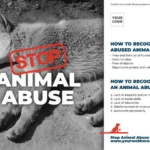Animal cruelty is a term that evokes strong emotions and images of suffering. But what exactly constitutes animal cruelty? To understand this complex issue, it is crucial to dissect its definition and recognize the myriad forms it takes around the world. Animal cruelty can be broadly described as the infliction of suffering, harm, or distress upon any animal, which manifests in various forms, from deliberate acts of violence to negligent care. This is a pervasive phenomenon that extends beyond mere definitions and permeates cultures, economies, and social paradigms worldwide.
At its core, animal cruelty is often categorized into two main types: active cruelty and passive cruelty. Active cruelty involves intentional actions aimed at causing pain or suffering. These may include physical abuse, such as beating, mutilation, or abandonment of animals in perilous conditions. Passive cruelty, on the other hand, stems from neglect, where caretakers fail to provide appropriate food, water, shelter, or medical care, resulting in the animal’s distress and suffering over time.
The implications of animal cruelty extend far beyond ethical boundaries; they embody a significant social issue that reflects humanity’s relationship with the natural world. One potent illustration of this phenomenon is the global practices in industries such as factory farming, research laboratories, and entertainment. Here, animals endure extensive psychological and physical harm, raising profound questions about our moral obligations toward sentient beings. Millions of animals are confined in cramped quarters, subjected to inhumane treatment, and deprived of natural behaviors that are essential for their well-being.
Moreover, animal cruelty is not confined to any particular region or culture. It is a global issue that transcends geographical and cultural boundaries. In some cultures, practices viewed as barbaric by others, such as dog fighting or bullfighting, are deeply ingrained traditions. Addressing animal cruelty requires a nuanced understanding of the cultural context that engages both empathy and education. Each region possesses unique traditions and practices that can either harm or protect the welfare of animals. Education and awareness-raising campaigns initiatives can engage communities in meaningful conversations, transforming perspectives towards more compassionate relationships with animals.
There is a plethora of legislation globally aimed at combating animal cruelty, yet enforcing these laws often presents challenges. Animal rights activists strive to reinforce legal frameworks that protect animals while simultaneously fostering a societal ethos that values their welfare. Countries such as the United States, Canada, and the European Union have established laws designed to prevent abuse and ensure humane treatment, yet there remain significant gaps in enforcement and public awareness. To shift the tide, animal welfare organizations are working diligently to advocate for stronger laws, encourage investigations, and champion harsher penalties for offenders, thus reinforcing societal norms that champion compassionate treatment.
The global impact of animal cruelty is vast and multifaceted. It extends beyond the individual animals being harmed; the consequences ripple through ecosystems, public health, and societal well-being. The exploitation of animals can disrupt ecological balances, threaten biodiversity, and contribute to the emergence of zoonotic diseases—diseases that can be transmitted between animals and humans. As populations continue to expand and natural habitats diminish, the urgency of addressing animal cruelty becomes increasingly paramount, demanding immediate action from both individuals and lawmakers worldwide.
In the realm of public health, animal cruelty can act as a barometer of societal health. Studies indicate a correlation between animal cruelty and domestic violence, suggesting that individuals who perpetrate violence against animals often exhibit broader patterns of aggression towards humans. The cycle of abuse underscores the importance of intervention and education: if we can address the root causes of cruelty towards animals, we may prevent future generational violence. Understanding the psychological dimensions of cruelty not only fosters empathy but also provides the necessary tools for prevention and intervention in broader societal contexts.
Furthermore, animal cruelty reflects an inherent disconnection between humans and the environment. In a world that is increasingly urbanized, many individuals lose sight of the intrinsic value of animals as sentient beings capable of experiencing pain and joy. Reclaiming a connection with nature and nurturing an ethic that prioritizes animal welfare can contribute significantly to mitigating cruelty. Educational initiatives in schools and communities can serve to instill values of compassion from an early age, promoting a culture of coexistence rather than domination over other species.
In conclusion, comprehending the multifaceted nature of animal cruelty necessitates an interdisciplinary approach that encompasses ethics, law, psychology, and environmental science. By acknowledging the serious ramifications of animal cruelty, we assume responsibility not only to protect animals from harm but also to cultivate a deeper understanding of our symbiotic existence with all living beings. Shifting perspectives is fundamental in creating a world where compassion prevails, leading humanity towards a future that honors the welfare of every creature. As awareness expands, it is our collective responsibility to transform this knowledge into action, ensuring a sustainable and humane future for both animals and humans alike.








